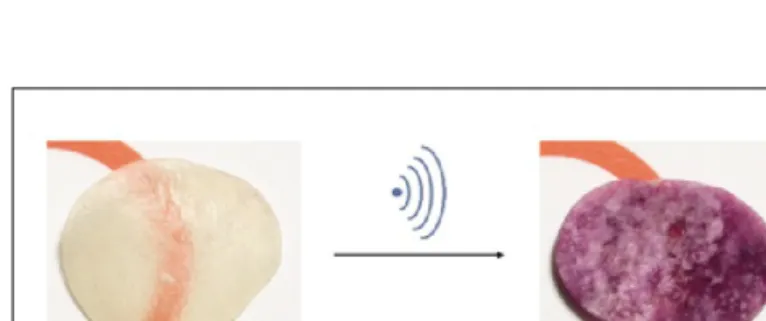666 CHIMIA 2014, 68, Nr. 9 Columns
Polymer and Colloid Highlights
Division of Polymers, Colloids and Interfaces
A Division of the Swiss Chemical Society
doi:10.2533/chimia.2014.666
If you are interested in submitting a new highlight, please contact: Prof. Dr. Raffaele Mezzenga, ETH Zürich
E-mail: raffaele.mezzenga@hest.ethz.ch, Tel.: +41 44 633 91 40 Mechanically Triggered Responses of Metallo supramolecular Polymers
Yoan C. Simon, Gina L. Fiore, Christoph Weder* *Correspondence: Prof. Dr. C. Weder, Adolphe Merkle Institute, University of Fribourg, CH-1700 Fribourg. E-mail: christoph.weder@unifr.ch
Keywords: Mechanochemistry · Metal-containing polymer · Supramolecular
The design of stimuli-responsive polymers has been fueled by the desire to impart new functionalities to next-generation materials. The concept to impart structural uses and create systems that can respond to changes in their environment constitutes a true paradigm shift in materials science. Owing to their dynamic nature and reversibility, non-covalent interactions have greatly contributed to the development of materials that are able to respond to a multitude of stimuli.[1–3]
Due to the high tunability of the constituting components (ligands, metals, counterions), metal-complexes are versatile supramolecular motifs and their incorporation into polymeric systems offers many opportunities to impart stimuli-responsive behavior.
We recently demonstrated that telechelic ditopic macroligands can be used in conjunction with metal salts to create optically healable polymers and debond-on-demand adhesives.[4,5]
Originally with the objective to probe the dynamic nature of metallosupramolecular polymers (MSPs), we recently embarked on the investigation of mechanically-induced responses of MSP networks.[6] In a newly designed system, mechanochemical
transduction happens both via reversible and irreversible disassembly of a 3D polymer network formed by the assembly of Eu(ClO4)3 with a telechelic poly(ethylene-co-butylene)
with 2,6-bis(1'-methylbenzimidazolyl)pyridine ligands at the termini (BKB) (Fig. 1). The Eu3+-complexes serve a dual role
as mechanically responsive motifs and built-in optical sensors that permit monitoring the extent of (dis)assembly through
their characteristic luminescence. Dose-dependent, reversible metal-ligand dissociation was observed upon application of ultrasonic pulses to solutions of the MSP networks. This effect was also transferrable to the solid state where mending of damaged objects with ultrasound was shown to be possible. The shockwave is responsible for the temporary disengagement of the metallosupramolecular motifs, which coincides with a reversible decrease of the polymer’s molecular weight and viscosity, allowing for the mending of interfaces through disassembly and re-polymerization.
Mechanochemical transduction was also imparted in the solid-state and observed via metal exchange when films of the MSPs were immersed in a Fe(ClO4)2solution and subjected to
ultrasound or a macroscopic force. Gratifyingly, no color change occurred by immersion in the salt solution, and only upon mechanochemical activation was an irreversible color change, characteristic of the Fe(BKB) complexes observed (Fig. 2). However, MSPs in which more strongly coordinating dipicolinate ligands were used do not dissociate upon exposure to ultrasound. An important aspect of this new approach is that the mechano-responsiveness of the materials can be readily tuned by altering the substituents of the supramolecular motifs, such as the ligand and metal ions. The general concept of mechanically-triggered responses can be applied to a wide range of materials that take advantage of dynamic, non-covalent interactions.
Received: August 20, 2014 [1] S. Seiffert, J. Sprakel, Chem. Soc. Rev. 2012, 41, 909.
[2] T. Aida, E. W. Meijer, S. I. Stupp, Science 2012, 335, 813.
[3] S. Bai, H. Zou, H. Dietsch, Y. C. Simon, C. Weder, Macromol. Chem. Phys.
2014, 215, 398.
[4] M. Burnworth, L. Tang, J. R. Kumpfer, A. J. Duncan, F. L. Beyer, G. L. Fiore, S. J. Rowan, C. Weder, Nature 2011, 472, 334.
[5] C. Heinzmann, S. Coulibaly, G. L. Fiore, C. Weder, ACS Appl. Mater. Interfaces 2014, 6, 4713.
[6] D. W. R. Balkenende, S. Coulibaly, S. Balog, Y. C. Simon, G. L. Fiore, C. Weder, J. Am. Chem. Soc. 2014, 136, 10493.
Eu3+
ll
BKB 3D network of [Eu(BKB)1.5](ClO4)3
Fig. 1. Schematic of the supramolecular polymerization of ligand-terminated macromonomers with europium salts and chemical structure of the mechano-responsive metallosupramolecular polymers studied.
Fig. 2. Images of [Eu(BKB)1.5](ClO4)3films after 5 days of swelling in a
solution of Fe(ClO4)2in CH3CN before (left) and after (right) 60 min of
